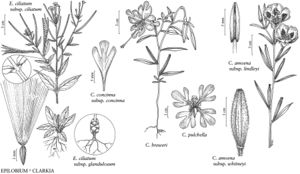Clarkia pulchella
Fl. Amer. Sept. 1: 260, plate 11. 1813. (as Clarckia)
Stems erect, to 50 cm, glabrous or puberulent. Leaves: petiole 0–10 mm; blade linear to lanceolate, 2–8 cm. Inflorescences racemes, axis straight or recurved; buds pendent. Flowers: floral-tube minutely strigillose in distal 1/2 inside; sepals reflexed together to1 side; corolla rotate, petals very broadly fan-shaped, 10–30 mm, lateral lobes 1–5 mm; stamens 8, unequal, 4 fertile, 4 sterile and reduced, subtended by puberulent scales, outer anthers lavender to white, inner much smaller, sterile; ovary shallowly 8-grooved; stigma exserted beyond anthers. Capsules 10–30 mm; pedicel 3–10 mm. Seeds dark-brown, 1 mm, scaly, crest to 0.1 mm, inconspicuous. 2n = 24.
Phenology: Flowering May–Jul.
Habitat: Openings in sagebrush and coniferous forests.
Elevation: 500–2200 m.
Distribution
B.C., Idaho, Mont., Oreg., S.Dak., Wash., Wyo.
Discussion
Clarkia pulchella is the only North American species in the genus that does not occur in California; instead it is found throughout most of eastern Oregon and Washington, western Idaho, and northwestern Montana, to southern British Columbia, with disjunct occurrences in Bannock County in Idaho, Teton County in Wyoming, and Meade County in South Dakota. It was first discovered in 1806 by Meriwether Lewis during the Lewis and Clark expedition, and was the first species named in the new genus Clarkia.
Clarkia pulchella is an allopolyploid that combines morphological characteristics of sect. Myxocarpa (C. borealis and relatives), which includes two species with 2n = 10, and sect. Eucharidium (C. concinna and C. breweri) with 2n = 14. Molecular data support a relationship with sect. Eucharidium but at present show no direct association with sect. Myxocarpa.
Clarkia elegans Poiret is an illegitimate name that pertains here.
Selected References
None.
